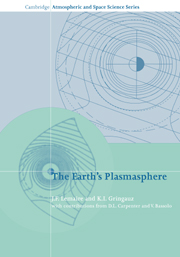Book contents
- Frontmatter
- Contents
- Preface
- Foreword
- Dedication
- Introduction
- Chapter 1 Discovery of the plasmasphere and initial studies of its properties
- Chapter 2 Electromagnetic sounding of the plasmasphere
- Chapter 3 Plasmasphere measurements from spacecraft
- Chapter 4 A global description of the plasmasphere
- Chapter 5 Theoretical aspects related to the plasmasphere
- Epilogue
- References
- Index
Chapter 4 - A global description of the plasmasphere
Published online by Cambridge University Press: 24 November 2009
- Frontmatter
- Contents
- Preface
- Foreword
- Dedication
- Introduction
- Chapter 1 Discovery of the plasmasphere and initial studies of its properties
- Chapter 2 Electromagnetic sounding of the plasmasphere
- Chapter 3 Plasmasphere measurements from spacecraft
- Chapter 4 A global description of the plasmasphere
- Chapter 5 Theoretical aspects related to the plasmasphere
- Epilogue
- References
- Index
Summary
Introduction
In the previous chapters, we have described different methods of observations which have been used over three decades to study the plasmasphere, its shape, ionic composition, dynamics and deformations during geomagnetic substorms. In this chapter we wish to put together all pieces with the hope that an up-to-date global picture of the plasmasphere will emerge. We briefly mention theories and models proposed to explain various features of the plasmasphere, empirical models being presented where relevant. Discussion of theoretical aspects will be found in Chapter 5.
The ionosphere as a source and sink for plasmaspheric particles
The ionosphere of the earth has been divided into different layers, the D-, E-, and F-regions. Above ∼ 300 km altitude where the maximum ionization occurs in the F-region, the thermal ion and electron densities steadily decrease with altitude. This region, which is the base of the topside ionosphere, extends deep into the magnetosphere. It forms the plasmasphere at low and middle latitudes, the plasmatrough at high and mid-latitudes, and the polar wind at high latitudes (see Fig. 4.1).
Figure 4.2a illustrates the daytime ionospheric and atmospheric composition, based on early IQSY mass spectrometer measurements. It shows that, below 1000 km altitude, ions remain minor constituents of the earth's atmosphere. Below 500 km O+ is generally the dominant ionic constituent. Above 600 km, there is a transition level where H+ become the dominant ions. Under exceptional geophysical conditions the He+ ion density can exceed the density of O+ ions and the density of H+ ions in an intermediate altitude range (He+ belt).
- Type
- Chapter
- Information
- The Earth's Plasmasphere , pp. 159 - 220Publisher: Cambridge University PressPrint publication year: 1998



